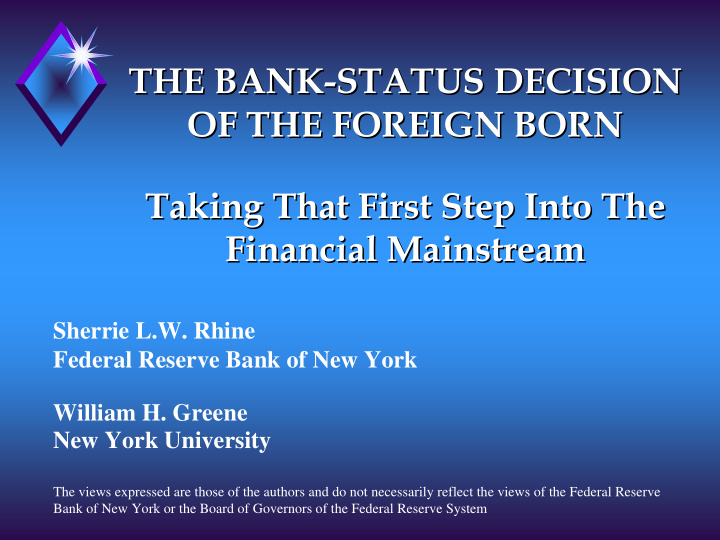



THE BANK- -STATUS DECISION STATUS DECISION THE BANK OF THE FOREIGN BORN OF THE FOREIGN BORN Taking That First Step Into The Taking That First Step Into The Financial Mainstream Financial Mainstream Sherrie L.W. Rhine Federal Reserve Bank of New York William H. Greene New York University The views expressed are those of the authors and do not necessarily reflect the views of the Federal Reserve Bank of New York or the Board of Governors of the Federal Reserve System
PURPOSE OF STUDY PURPOSE OF STUDY Gain a better understanding about immigrant financial integration in terms of their bank-status decision
BANK- - STATUS STATUS BANK DECISION DECISION Household chooses whether or not to own either a checking or a savings account BANKED OR UNBANKED
UNBANKED UNBANKED According to the Survey of Consumer Finances: U.S. Families 9.1 % Whites, non-Hispanic 5.1 % Non-White or Hispanic 21.8 %
BENEFITS FROM BENEFITS FROM PARTICIPATION IN THE PARTICIPATION IN THE FINANCIAL MAINSTREAM FINANCIAL MAINSTREAM - Asset Building and Wealth Accumulation - Consumer Legal Protections - Informed Financial Decisions - Community Stability and Vitality
RESEARCH QUESTION RESEARCH QUESTION How do socioeconomic and demographic characteristics influence the decision to be unbanked ?
EMPIRICAL FRAMEWORK FRAMEWORK EMPIRICAL Probability of being UNBANKED depends on socioeconomic and demographic characteristics
EMPIRICAL FRAMEWORK EMPIRICAL FRAMEWORK Model includes a random component, RHO, to capture the cross period correlation of unobserved individual effects (e.g., family-specific characteristics or possibly home country attributes)
EMPIRICAL FRAMEWORK EMPIRICAL FRAMEWORK Previous research finds that the decision to be unbanked is: Most Likely Least Likely less educated married younger larger families lower-income greater net worth minorities employed
EMPIRICAL FRAMEWORK EMPIRICAL FRAMEWORK Immigrant-specific factors include: Citizenship Status Year of Migration (tenure in the U.S.) Age at Migration
SAMPLE DESCRIPTION SAMPLE DESCRIPTION Survey of Income Program Participation-SIPP 1996 - 2000 Longitudinal Survey Total Household Observations 80,972 U.S. Born 73,832 Immigrant 7,140
DATA AND SAMPLE DATA AND SAMPLE DESCRIPTION DESCRIPTION Immigrant Groups Number of Households (1996 - 2000) Mexican 1,860 Other Latin American 1,892 European 1,900 Asian 1,488
SELECTED FACTS SELECTED FACTS IMMIGRANT IMMIGRANT HOUSEHOLDS HOUSEHOLDS Mexican Latin American European Asian < High School 70% 33 % 16% 14% LMI 84% 65% 53% 46% Poverty 32% 23% 11% 16% Family Size 4.2 2.9 2.4 3.4 U.S. Citizen 24% 61% 67% 56%
UNBANKED UNBANKED HOUSEHOLDS HOUSEHOLDS Percentage of Households Immigrant Groups: Mexican 53 Latin American 37 Asian 20 European 17 U.S. Born: Black 46 Hispanic 34 Other Race (Asian, Native American or Aleut) 34 White 14
MEXICAN IMMIGRANTS MEXICAN IMMIGRANTS Pr(UNBANKED) Pr(UNBANKED) Decrease Increase % Points % Points Net Worth 41 - 54 Less than HS 17 Income 6 - 13 Poverty 12 Work Effort 13 Citizenship 12 - 17 Yr Migrated 16 - 26
LATIN AMERICAN LATIN AMERICAN IMMIGRANTS IMMIGRANTS Pr(UNBANKED) Pr(UNBANKED) Decrease Increase % Points % Points Net Worth 59 - 74 Less than HS 30 Income 11 - 16 Work Effort 10
EUROPEAN IMMIGRANTS EUROPEAN IMMIGRANTS Pr(UNBANKED) Pr(UNBANKED) Decrease Increase % Points % Points Net Worth 54 - 69 Less than HS 10 Upper Income 8
ASIAN IMMIGRANTS ASIAN IMMIGRANTS Pr(UNBANKED) Pr(UNBANKED) Decrease Increase % Points % Points Net Worth 43 - 52 Less than HS 11 Upper Income 11
SUMMARY SUMMARY Most Influential Characteristics All Immigrants: Education Net Worth Household Income Mexican immigrants: Poverty Work Effort Citizenship Status Year at Migration
POLICY IMPLICATIONS POLICY IMPLICATIONS Market Innovations � � Financial Education
Recommend
More recommend